''Pulling Together"

Some people succeed because they are destined to, but most people succeed because they are determined to.

''Pulling Together"

Some people succeed because they are destined to, but most people succeed because they are determined to.
Darryl Peal, Adviser
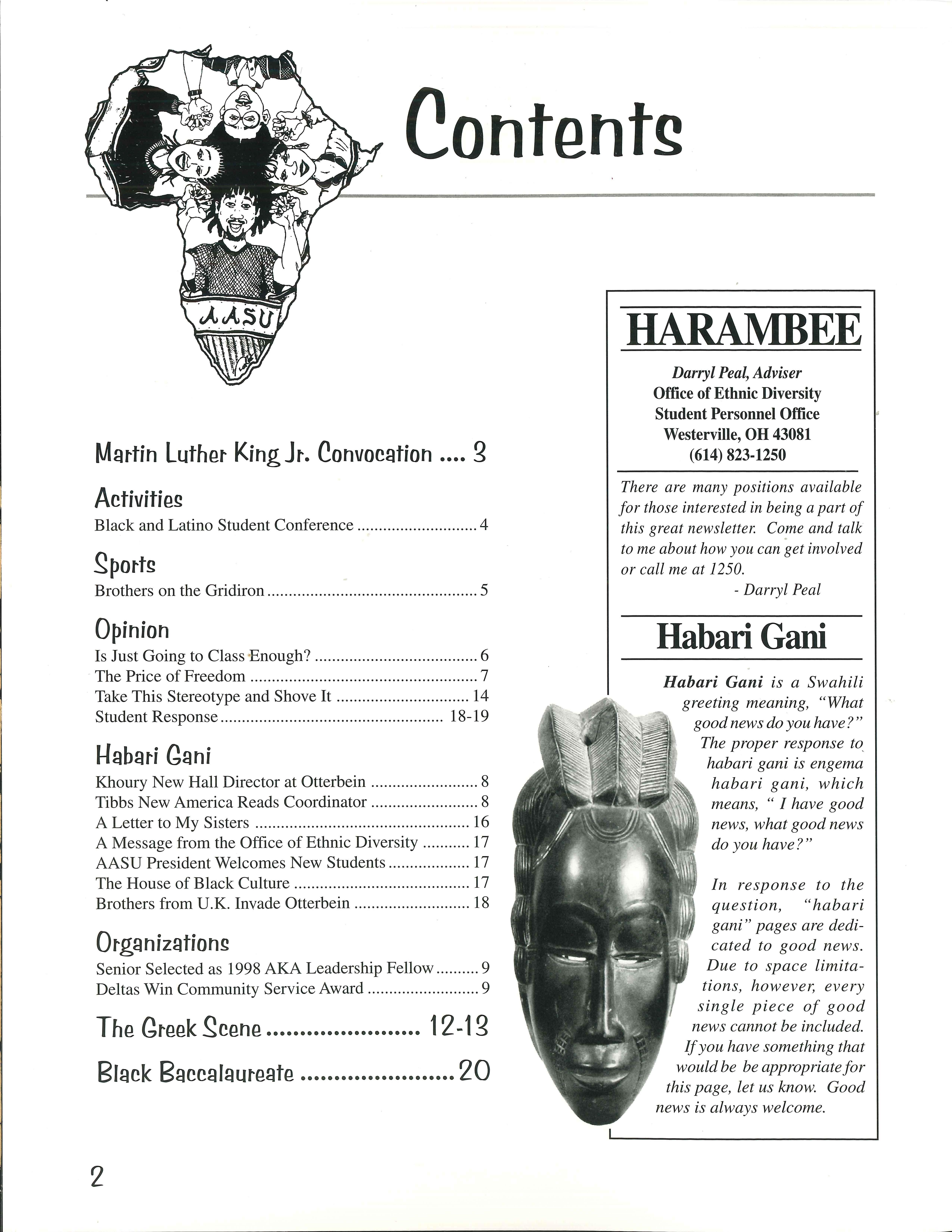
There are many positions available for those interested in being a part of this great newsletter. Come and talk to me about how you can get involved or call me at 1250.
- Darryl Peal
Habari Gani is a Swahili greeting meaning, "What good news do you have?"
The proper response to habari gani is engema habari gani, which means, " I have good news, what good news do you have?"
In response to the question, "habari gani" pages are dedicated to good news. Due to space limitations, however, every single piece of good news cannot be included. If you have something that would be be appropriate for this page, let us know. Good news is always welcome.
Dr. Julianne Malveaux is an economist, writer, and syndicated columnist who has been described as one of the most provocative, progressive and iconoclastic public intellectuals in the country. Since 1990, her weekly column has appeared nationally in over twenty newspapers through the King Features Syndicate. She has written for a number of popular publications, including Emerge and Essence . She is also a regular contributor to Ms. and USA Today, and is a weekly contributor to the San Francisco Sun Reporter.
Dr. Malveaux is currently the host And
executive producer of "The Julianne Malveaux Show" a news and public affairs show based in Washington DC. Here program reaches over 15 markets on the Pacifica network. Among the many influential headliners that her talk show has featured are Congressional Representatives Eleanor Holmes Norton, Floyd Flake, Charles Rangel, Cynthia McKinney, and the Reverend Jesse Jackson; entertainers, Ruby Dee and Billy Dee Williams; political analysts, Ron Walters and Linda Williams; authors Susan Taylor, John Edgar Wideman, and Ehtelbert Miller; activist, D Dorothy Hieght; and journalist, Dorothy Gilliam. Dr. Malveaux also provides regular radio and television' commentary on sociopolitical issues , and has teleconferences on topics ranging from Black Studies to campus gender relations.
Her popularity on the lecture circuit has reached a vast market that ranges from civic and academic organizations to corporations and associations. Speaking to over fifty groups a year, some of her most significant speeches include an address on diversity to the New York Times
Leisure Magazine Group, to the Indianapolis Conference on the status of women, to the Urban Studies Department at the University of California, Los Angeles, and to the National Black Child Development Institute's annual conference.
As a scholar, Dr. Malveaux has most recently been visiting faculty at the University of California, Berkeley in the African American Studies Department. Her research focuses on the labor market, public policy, and the impact they have on women and minori-
ties. She is the coeditor of the book, Slipping Through the Cracks: The Status of Black Women
( 1986), and is the author of a collection of columns, Sex, Lies, and Stereotypes: Perspectives of a Mad Economist ( 1994 ).
Dr. Malveaux was honored by the National Council of Negro Women in November 1987 as a "Black Woman Who Makes it Happen" for the legislative work, her efforts to raise peace and justice issues through her writing, and her research on the status of Black women in the Labor market. She appeared in the Who's Who ofAmerican Women, and was listed in 1985 as one of America's top 100 Black Business and Professional Women by Dollars and Sense magazine.
Dr Malveaux is President of the National Association of Negro Business and Professional Women's Clubs . She is vice chair of the Board of Directors of the National Child Labor Committee and serves on the board of the Center for Policy Alternatives. She is captivating speaker who offers insight and expertise on some of the most provocative issues that effect our society.
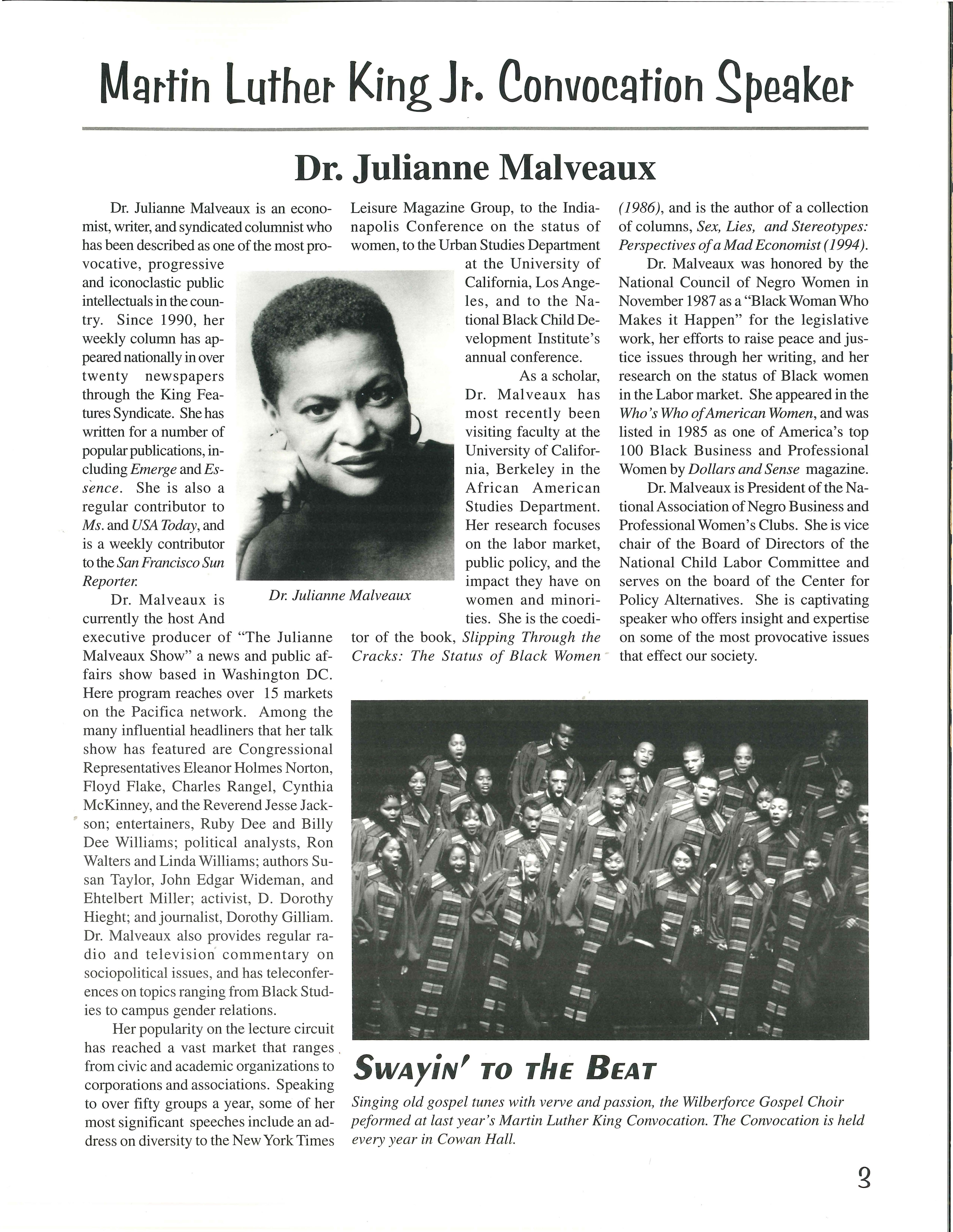
Singing old gospel tunes with verve and passion, the Wilberforce Gospel Choir peformed at last year's Martin Luther King Convocation . The Convocation is held every year in Cowan Hall
The Office of Ethnic Diversity and the Otterbein College African-American Student Union were the proud host of the 1998 Black and Latino Student Conference on April 3 and 4, 1998. The theme of the conference was: UNITY THROUGH COMMUNITY: Lifting Our Level of Consciousness.
The conference was opened by Gloria Long-Groves. Ms. Long-Groves opened the conference with an empowerment ceremony entitled, "And Still I Rise ."
The Keynote Speaker, during lunch was, Dr. Charles E. Booth, who was born and raised in Baltimore Dr. Booth has served as pastor of Mt. Olivet Baptist Church since 1978. He received a bachelor's degree from Howard University, a master of divinity degree from Eastern Baptist Theological Seminary, and a doctor of ministry degree from the United Theological Seminary. He has been a guest speaker at universities, churches and church conventions throughout the world, and has received several preaching and service awards. He has had sermons published in The Secret Place, a magazine of the American Baptist Convention, and in Outstanding Black Sermons. Dr. Booth currently serves as a professor of preaching at the United Theological Seminary, and has lectured or taught at the Methodist Theological School in Ohio and Trinity Lutheran Seminary.
Four workshops were presented at the conference. The workshops challenged everyone to take a closer look at themselves and how they interact with people in the community.
The first workshop was: "The Great Divide : Defining Your Identity" African American students were challenged to look at how they define themselves- -students also looked at important questions like "How Black is Black?" "Are you Black Enough?" "Does Growing Up in the Suburbs and Going To Private Schools Redefine You?" "Do Black Greeks Help or Hurt the Community?" These and many more issues were identified as reasons why African American students have difficulty building community. The workshop helped to critically look at and identify issues and work toward strategies for eliminating the divisions.
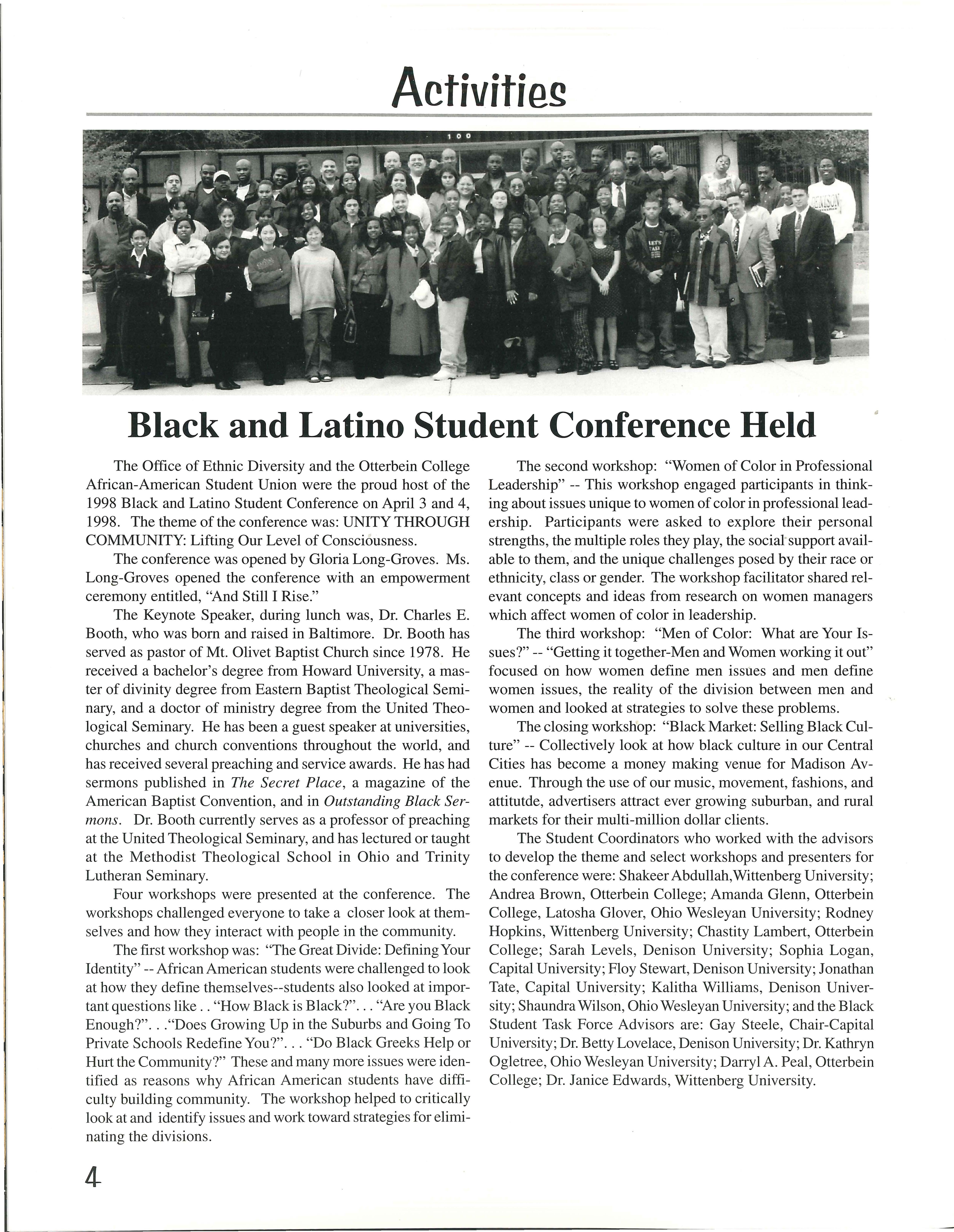
The second workshop: "Women of Color in Professional Leadership" This workshop engaged participants in thinking about issues unique to women of color in professional leadership Participants were asked to explore their personal strengths, the multiple roles they play, the social support available to them, and the unique challenges posed by their race or ethnicity, class or gender. The workshop facilitator shared relevant concepts and ideas from research on women managers which affect women of color in leadership.
The third workshop: "Men of Color: What are Your Issues?" "Getting it together-Men and Women working it out" focused on how women define men issues and men define women issues, the reality of the division between men and women and looked at strategies to solve these problems
The closing workshop: "Black Market: Selling Black Culture" -- Collectively look at how black culture in our Central Cities has become a money making venue for Madison Avenue. Through the use of our music, movement, fashions, and attitutde, advertisers attract ever growing suburban, and rural markets for their multi-million dollar clients.
The Student Coordinators who worked with the advisors to develop the theme and select workshops and presenters for the conference were: Shakeer Abdullah,Wittenberg University; Andrea Brown, Otterbein College; Amanda Glenn, Otterbein College, Latosha Glover, Ohio Wesleyan University; Rodney Hopkins , Wittenberg University; Chastity Lambert, Otterbein College; Sarah Levels , Denison University; Sophia Logan, Capital University; Floy Stewart, Denison University; Jonathan Tate, Capital University ; Kalitha Williams , Denison University; Shaundra Wilson , Ohio Wesleyan University; and the Black Student Task Force Advisors are: Gay Steele, Chair-Capital University; Dr. Betty Lovelace, Denison University; Dr Kathryn Ogletree, Ohio Wesleyan University ; Darryl A. Peal, Otterbein College; Dr. Janice Edwards, Wittenberg University.
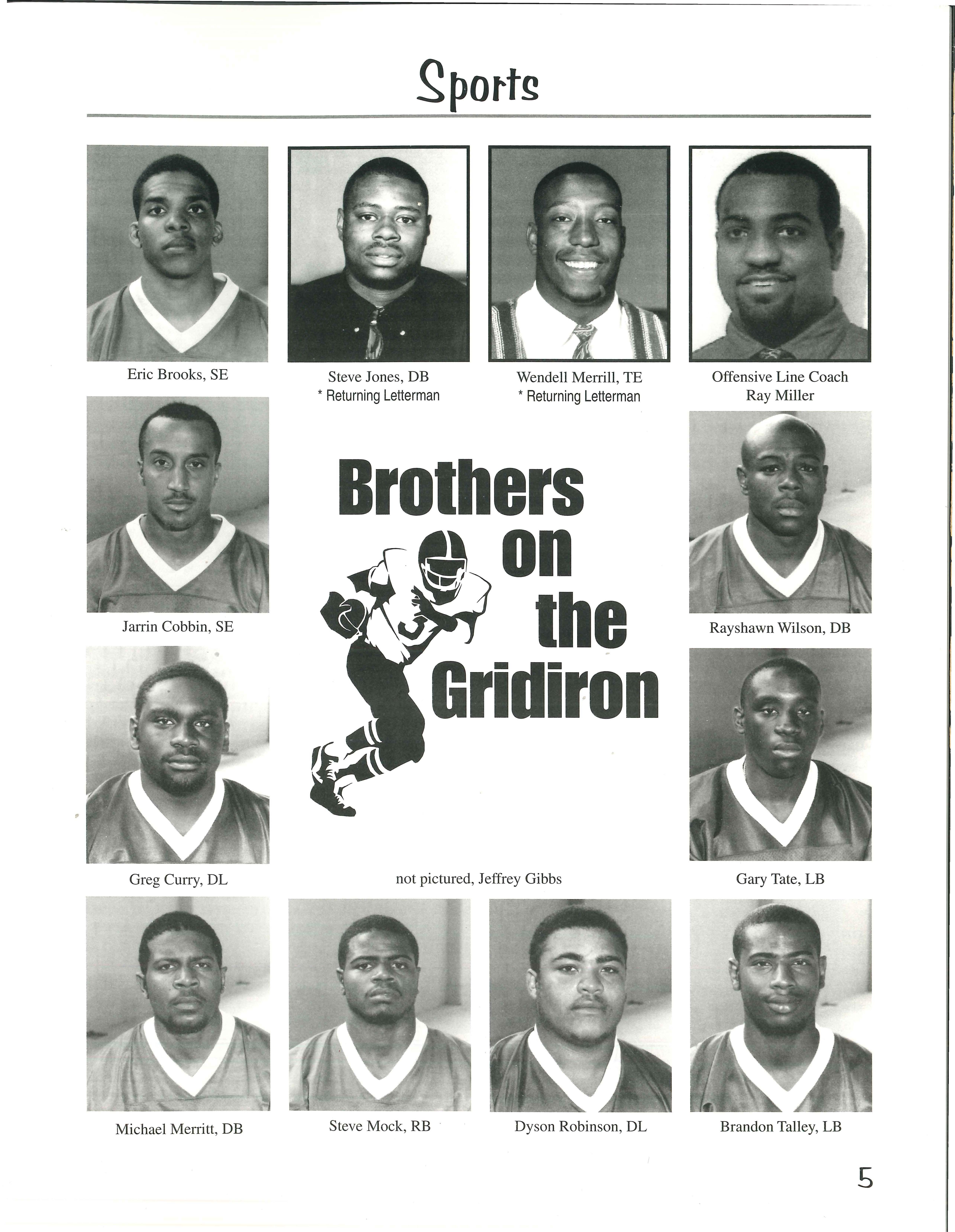
by Aaron Martin '97
No, it is not - we are not even going to tiptoe around the answer. Being here was not enough for the students who sat at "White Only" lunch counters in the South during the sixties. Being here is only the beginning, because so many of our ancestors did not have the chance to go to college. Many of our friends never set their goals for a college education and our parents and grandparents were denied access to a college education . Many brothers and sisters never had the time to pursue college because they were taking care of children and families. Too many of our children will never have the chance to go to college if those of us who are in college forget that we are standing on the shoulders of our ancestors
Parties are fun. Road trips are fun. Hanging out eating a pizza with friends is fun. Even, in some strange and sick way, staying up cramming for an exam or to finish a paper that is due in the morning is fun (once you've graduated and don't have to anymore). But parties, road trips and pizza parties do nothing to get the next generation of Black folks into the spaces we leave vacant at institutions of higher learning when we graduate. We must fill the spaces we vacate with another positive Black face. We must avoid an "I gots mine," " It ' s all good ' attitude that afflicts too many of us " educated " Black folks
Men and women died for our right to be free from slavery Men and women died for our right to drink from the water fountain and use the same bathroom as white people. Men and
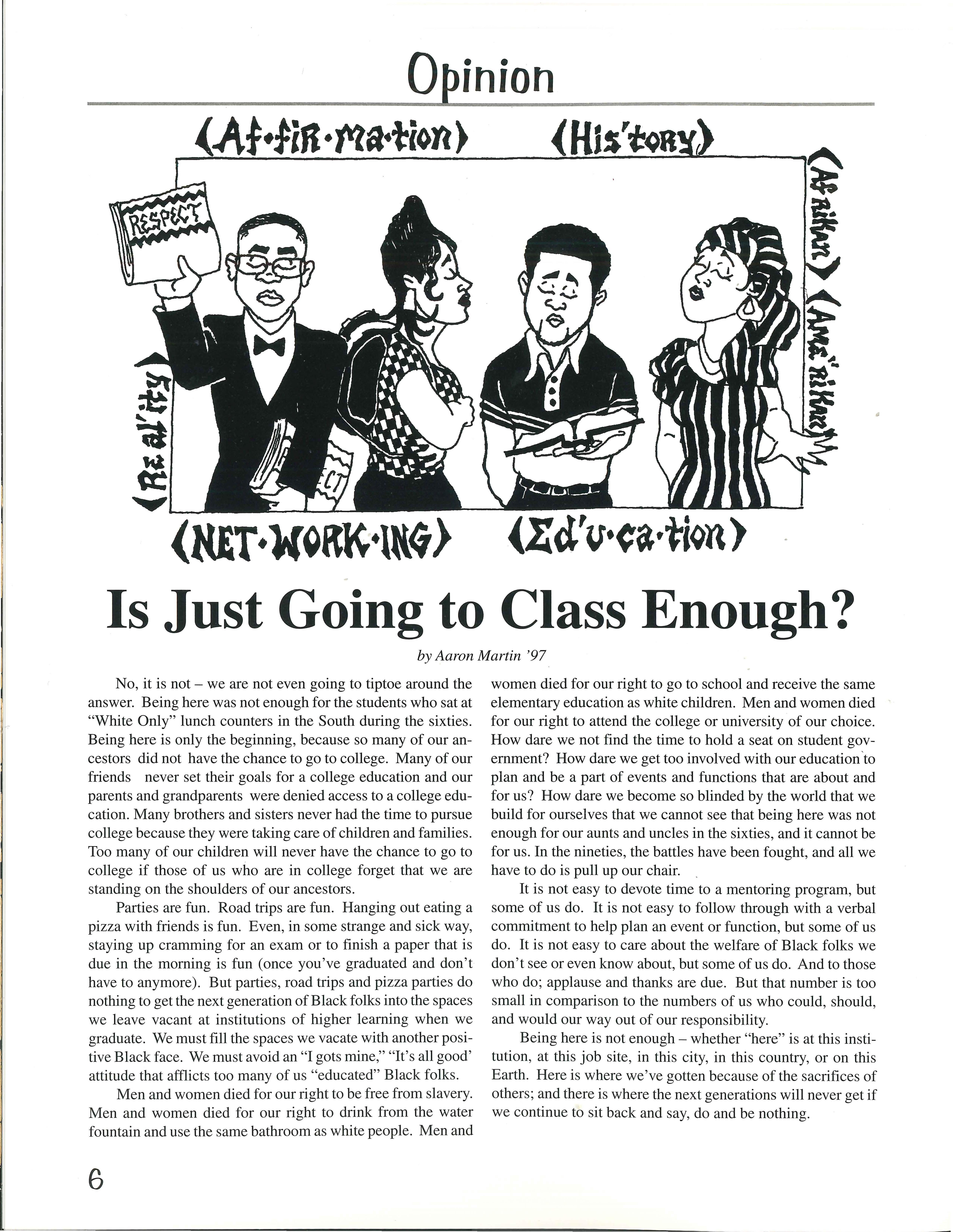
women died for our right to go to school and receive the same elementary education as white children. Men and women died for our right to attend the college or university of our choice How dare we not find the time to hold a seat on student government? How dare we get too involved with our education to plan and be a part of events and functions that are about and for us? How dare we become so blinded by the world that we build for ourselves that we cannot see that being here was not enough for our aunts and uncles in the sixties, and it cannot be for us. In the nineties, the battles have been fought, and all we have to do is pull up our chair.
It is not easy to devote time to a mentoring program, but some of us do. It is not easy to follow through with a verbal commitment to help plan an event or function, but some of us do It is not easy to care about the welfare of Black folks we don't see or even know about , but some ofus do And to those who do ; applause and thanks are due. But that number is too small in comparison to the numbers of us who could, should, and would our way out of our responsibility .
Being here is not enough - whether "here" is at this institution , at this job site , in this city, in this country, or on this Earth Here is where we ' ve gotten because of the sacrifices of others ; and there is where the next generations will never get if we continue to sit back and say, do and be nothing.
by Terrance Pratt, Senior; Capital University
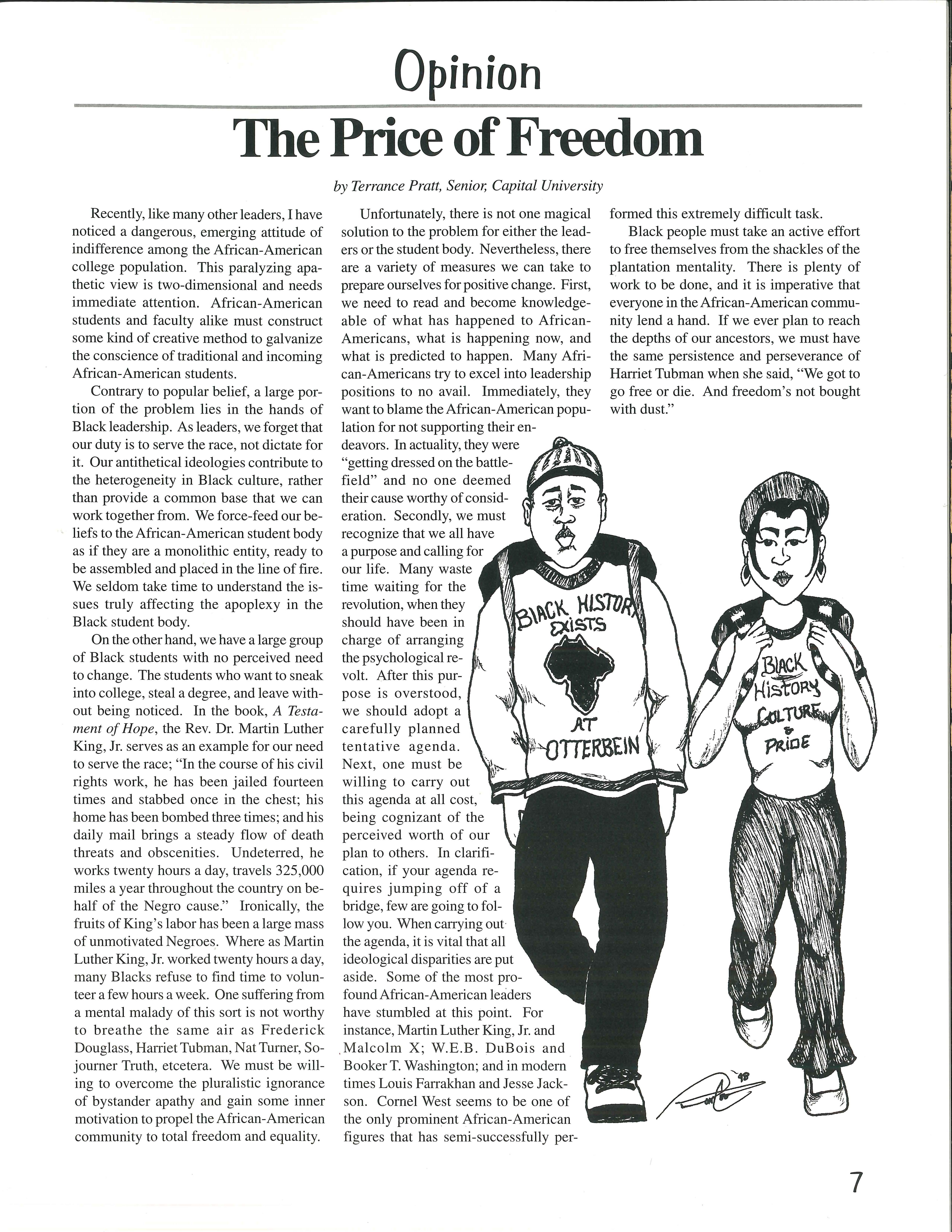
Recently, like many other leaders , I have noticed a dangerous, emerging attitude of indifference among the African-American college population This paralyzing apathetic view is two-dimensional and needs immediate attention. African-American students and faculty alike must construct some kind of creative method to galvanize the conscience of traditional and incoming African-American students.
Contrary to popular belief, a large portion of the problem lies in the hands of Black leadership As leaders, we forget that our duty is to serve the race, not dictate for it. Our antithetical ideologies contribute to the heterogeneity in Black culture, rather than provide a common base that we can work together from. We force-feed our beliefs to the African-American student body as if they are a monolithic entity, ready to be assembled and placed in the line of fire. We seldom take time to understand the issues truly affecting the apoplexy in the Black student body
On the other hand, we have a large group of Black students with no perceived need to change The students who want to sneak into college , steal a degree, and leave without being noticed. In the book, A Testament of Hope, the Rev. Dr. Martin Luther King, Jr. serves as an example for our need to serve the race; "In the course of his civil rights work, he has been jailed fourteen times and stabbed once in the chest; his home has been bombed three times; and his daily mail brings a steady flow of death threats and obscenities. Undeterred , he works twenty hours a day, travels 325 ,000 miles a year throughout the country on behalf of the Negro cause." Ironically, the fruits of King's labor has been a large mass of unmotivated Negroes . Where as Martin Luther King , Jr. worked twenty hours a day, many Blacks refuse to find time to volunteer a few hours a week. One suffering from a mental malady of this sort is not worthy to breathe the same air as Frederick Douglass, Harriet Tubman , Nat Turner, Sojourner Truth , etcetera. We must be willing to overcome the pluralistic ignorance of bystander apathy and gain some inner motivation to propel the African-American community to total freedom and equality.
Unfortunately, there is not one magical solution to the problem for either the leaders or the student body. Nevertheless , there are a variety of measures we can take to prepare ourselves for positive change. First, we need to read and become knowledgeable of what has happened to AfricanAmericans, what is happening now, and what is predicted to happen. Many African-Americans try to excel into leadership positions to no avail. Immediately, they want to blame the African-American population for not supporting their endeavors. In actuality, they were "getting dressed on the battlefield" and no one deemed their cause worthy of consideration. Secondly, we must recognize that we all have a purpose and calling for our life Many waste time waiting for the revolution, when they should have been in charge of arranging the psychological revolt. After this purpose is overstood, we should adopt a carefully planned tentative agenda. Next, one must be willing to carry out this agenda at all cost, being cognizant of the perceived worth of our plan to others In clarification, if your agenda requires jumping off of a bridge , few are going to follow you. When carrying out the agenda, it is vital that all ideological disparities are put aside Some of the most profound African-American leaders have stumbled at this point. For instance, Martin Luther King, Jr. and Malcolm X; W E B DuBois and BookerT. Washington; and in modern times Louis Farrakhan and Jesse Jackson Come) West seems to be one of the only prominent African-American figures that has semi-successfully per-
formed this extremely difficult task. Black people must take an active effort to free themselves from the shackles of the plantation mentality There is plenty of work to be done, and it is imperative that everyone in the African-American community lend a hand. If we ever plan to reach the depths of our ancestors, we must have the same persistence and perseverance of Harriet Tubman when she said, "We got to go free or die. And freedom's not bought with dust."
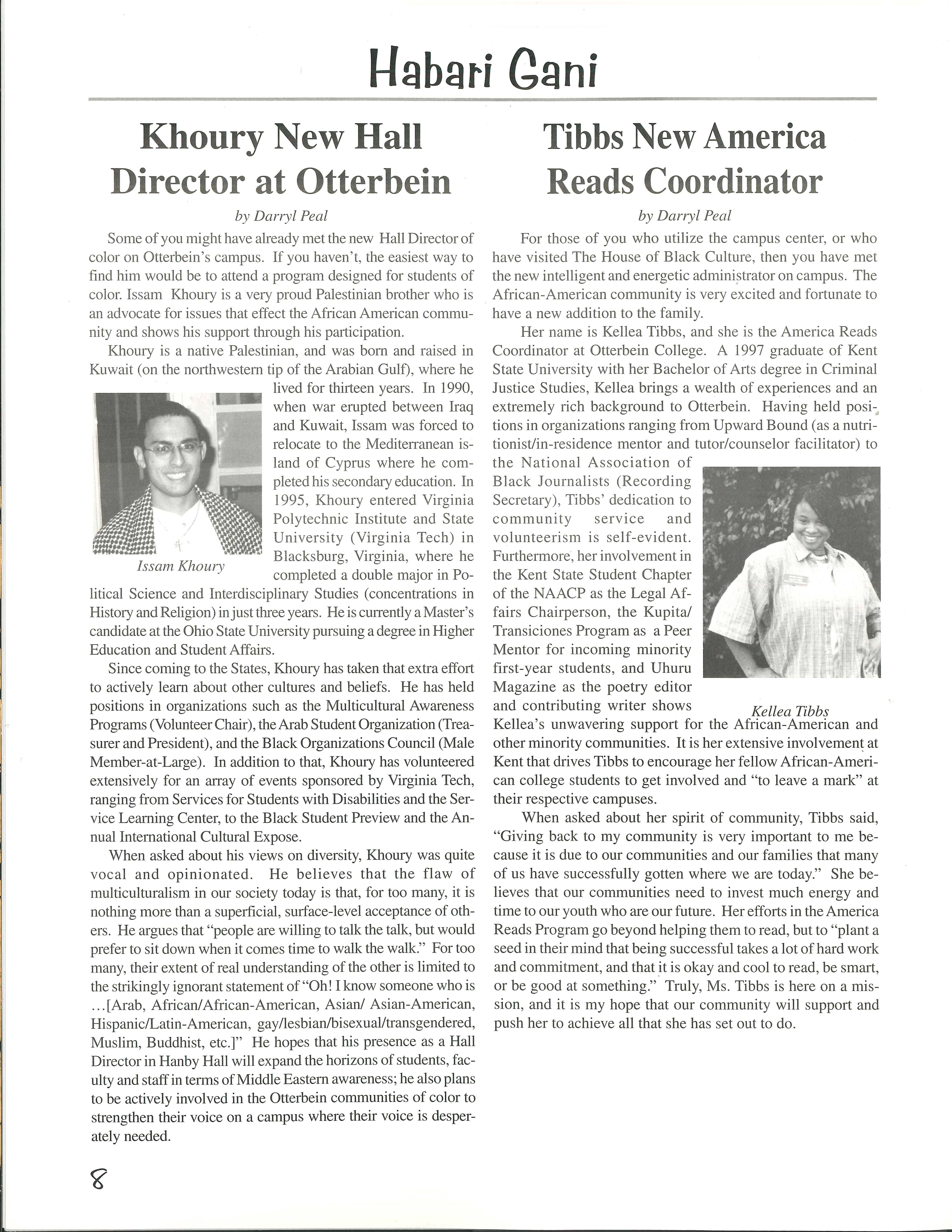
by Darry l Pea l
Some of you might have already met the new Hall Director of color on Otterbein's campus. If you haven't , the easiest way to find him would be to attend a program designed for students of color. Issam Khoury is a very proud Palestinian brother who is an advocate for issues that effect the African American community and shows his support through his participation Khoury is a native Palestinian , and was born and raised in Kuwait (on the northwestern tip of the Arabian Gulf), where he
lssam Khoury liv ed for thirtee n ye ars. In 199 0 , w hen war erup ted between Iraq an d K uwait , Issam was for ced to relocate to the MediteITanean island of Cyprus where he completed his secondary education In 1995 , Khoury entered Virginia Polytechnic Instit u te and State University (Virginia Tech) in Blacksburg, Virgi nia, where h e comp lete d a dou ble major in Poli ti cal Scie nc e and In terdi sciplinary Studies (concentra tion s in History an d Reli gion) in ju st three ye ars . H e is cu ITently a M aste r's candid ate at the Ohi o State Univers ity pursuing a degree in Higher Educ ation and Stu de nt Affairs.
Since corning to the States , Khoury has taken that extra effort to actively learn about other cultures and beliefs. He has held positions in organizations such as the Multicultural Awareness Programs (Volunteer Chair) , the Arab Student Organization (Treasurer and President), and the Black Organizations Council (Male Member-at -Large). In addition to that , Khoury has volunteered extensively for an array of events sponsored by Virginia Tech , ranging from Services for Students with Disabilities and the Service Learning Center, to the Black Student Preview and the Annual International Cultural Expose.
When asked about his views on diversity, Khoury was quite vocal and opinionated He believes that the flaw of multiculturalism in our society today is that , for too many, it is nothing more than a superficial , surface -level acceptance of others He argues that "people are willing to talk the talk , but would prefer to sit down when it comes time to walk the walk ." For too many , their extent of real understanding of the other is limited to the strikingly ignorant statement of " Oh! I know someone who is ... [Arab , African/African - American , Asian/ Asian-American , Hispanic/Latin-American , gay/lesbian/bisexual/transgendered, Muslim , Buddhist, etc ]" He hopes that his presence as a Hall Director in Hanby Hall will expand the horizons of students, faculty and staff in terms of Middle Eastern awareness ; he also plans to be actively involved in the Otterbein communities of color to strengthen their voice on a campus where their voice is desperately needed.
by Da rry l Peal
For those of you who utilize the campus center, or who have visited The House of Black Culture, then you have met the new intelligent and energetic administrator on campus The African - American community is very excited and fortunate to have a new addition to the family.
Her name is Kellea Tibbs, and she is the America Reads Coordinator at Otterbein College. A 1997 graduate of Kent State Universi t y w ith her Bachelor of Arts degree in Criminal Ju st ice Stud ies, Kell e a b ri ng s a wea l th of exper iences a nd an ex tremel y ri c h bac kgro u nd to Otte rbe i n. Ha vi ng held posi. ti o ns i n organ i za ti ons ran g ing fro m Upwar d Bound (as a n ut ritionis t/in -residence mentor and tutor/counselor facilita tor) to the National Association of Black Journalists (Recording Secretary), Tibbs' dedication to community service and volunteerism is self - evident. Furthermore, her i nvolvement in the Ke nt State St uden t Chapt er of the NAACP as th e L ega l Affair s Chairperson , the K up i ta/ Tra nsici o nes P rogram a s a P eer Mento r for incoming minority first-year students, and Uhuru Magaz i ne as the poetry editor and contributing writer shows Kellea Tibbs Kellea ' s unwavering support for the African-American and other minority communities. It is her extensive involvement at Kent that drives Tibbs to encourage her fellow African -American college students to get involved and "to leave a mark" at their respective campuses
When asked about her spirit of community, Tibbs said, "Giving back to my community is very important to me because it is due to our communities and our families that many of us have successfully gotten where we are today." She believes that our communities need to invest much energy and time to our youth who are our future Her efforts in the America Reads Program go beyond helping them to read, but to " plant a seed in their mind that being successful takes a lot of hard work and commitment, and that it is okay and cool to read , be smart , or be good at something." Truly, Ms . Tibbs is here on a mission , and it is my hope that our community will support and push her to achieve all that she has set out to do.
Andrea Brown a senior presidential scholar from Lima, Ohio was selected by the Alpha Kappa Alpha Sorority Incorporated as a 1998 Leadership Fellow. The Leadership Fellow Program began in 1979 with the purpose of providing leadership training to outstanding undergraduate members of Alpha Kappa Alpha Sorority, Incorporated. The 1998 Leadership Fellows Program was sponsored by Alpha Kappa Alpha Sorority, Inc. in partnership with the Pillsbury Company for the second year to develop young women who will be prepared to assume job responsibilities in the workplace . The partnership is three-tiered with the following goals and objectives: (1) Training and development ; (2)Student
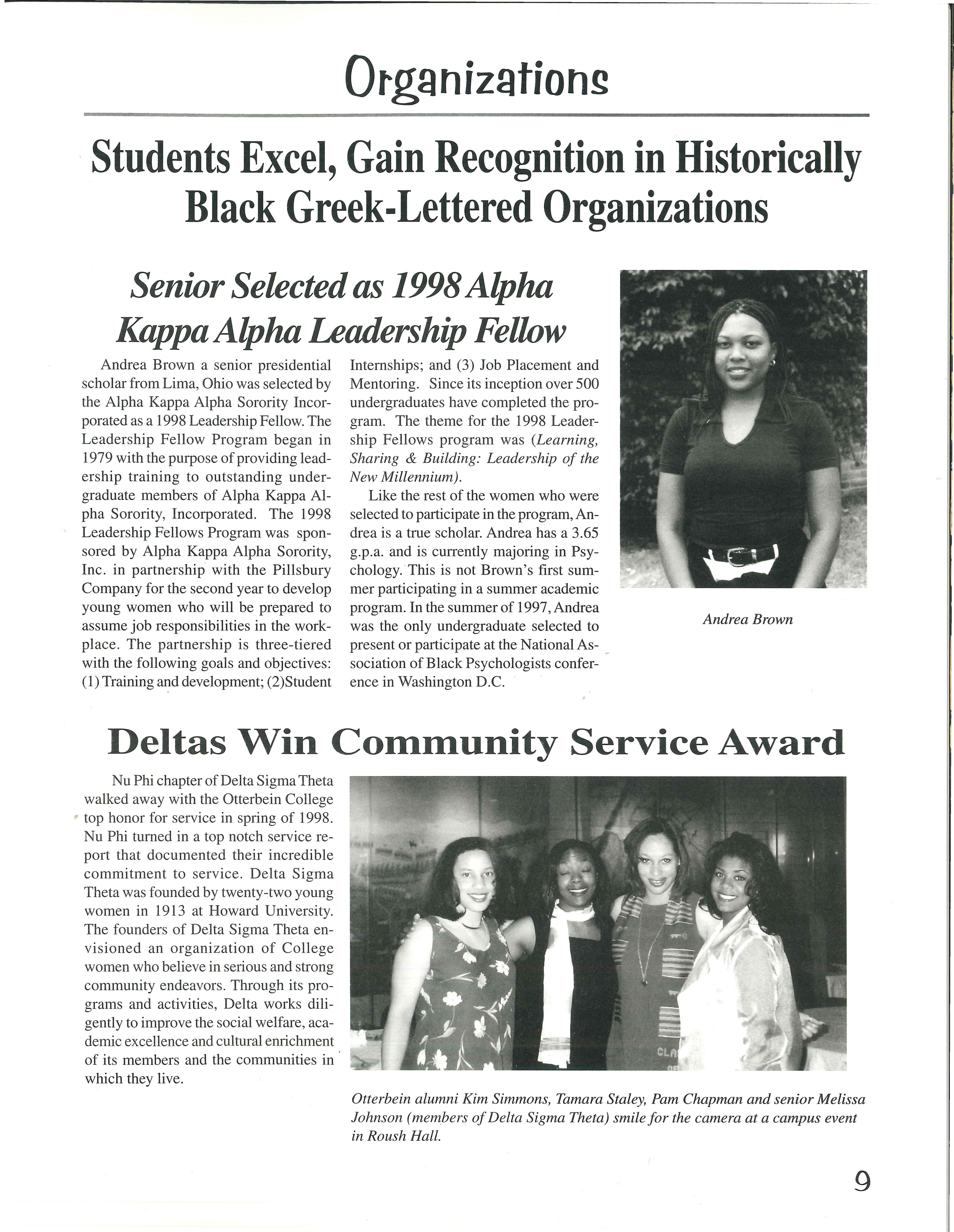
Internships ; and (3) Job Placement and Mentoring . Since its inception over 500 undergraduates have completed the program . The theme for the 1998 Leadership Fellows program was (Learning , Sharing & Building: Leadership of the New Millennium).
Like the rest of the women who were selected to participate in the program , Andrea is a true scholar. Andrea has a 3.65 g.p.a and is currently majoring in Psychology. This is not Brown's first summer participating in a summer academic program . In the summer of 1997, Andrea was the only undergraduate selected to present or participate at the National Association of Black Psychologists conference in Washington D.C.
Nu Phi chapter of Delta Sigma Theta walked away with the Otterbein College top honor for service i n spring of 1998 Nu Phi turned i n a top notch service report that documented their incredible commitment to service. Delta Si gma Theta was founded by twenty-two young women i n 1913 at Howard University. The founders of Delta Sigma Theta envisioned an organization of College women who believe in seriou s and strong community endeavors Through its programs and activities , Delta works diligently to improve the social welfare , academic excellence and cultural enrichment of its members and the communities in • which they live.
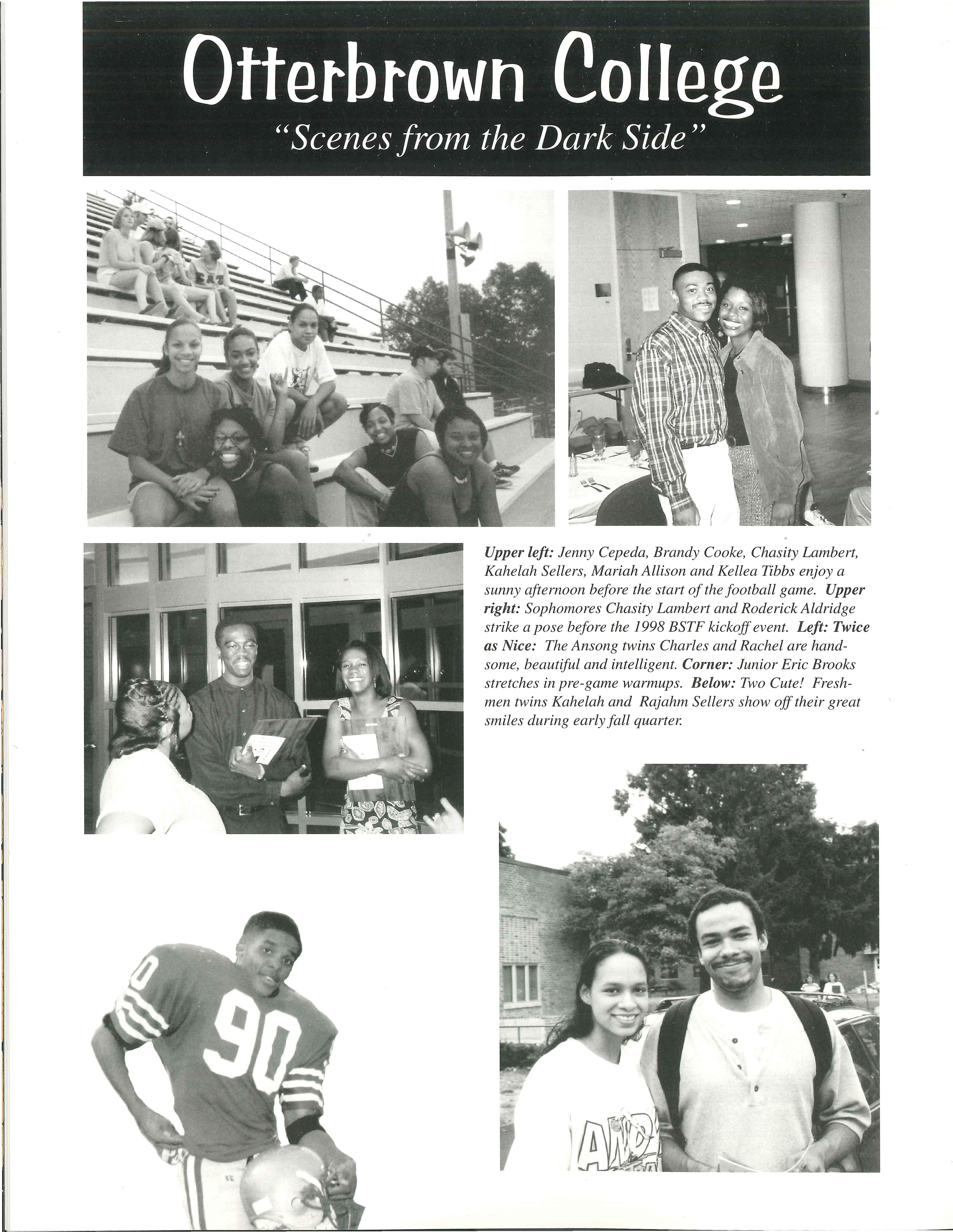
Upper left: Jenny Cepeda, Brandy Cooke, Chasity Lambert, Kahelah Sellers, Mariah Allison and Kellea Tibbs enjoy a sunny afternoon before the start of the football game. Upper right: Sophomores Chasity Lambert and Roderick Aldridge strike a pose before the 1998 BSTF kickoff event. Left: Twice as Nice: The Ansong twins Charles and Rachel are handsome, beautiful and intelligent. Corner: Junior Eric Brooks stretches in pre-game warmups. Below: Two Cute! Freshmen twins Kahelah and Rajahm Sellers show off their great smiles during early fall quarter.
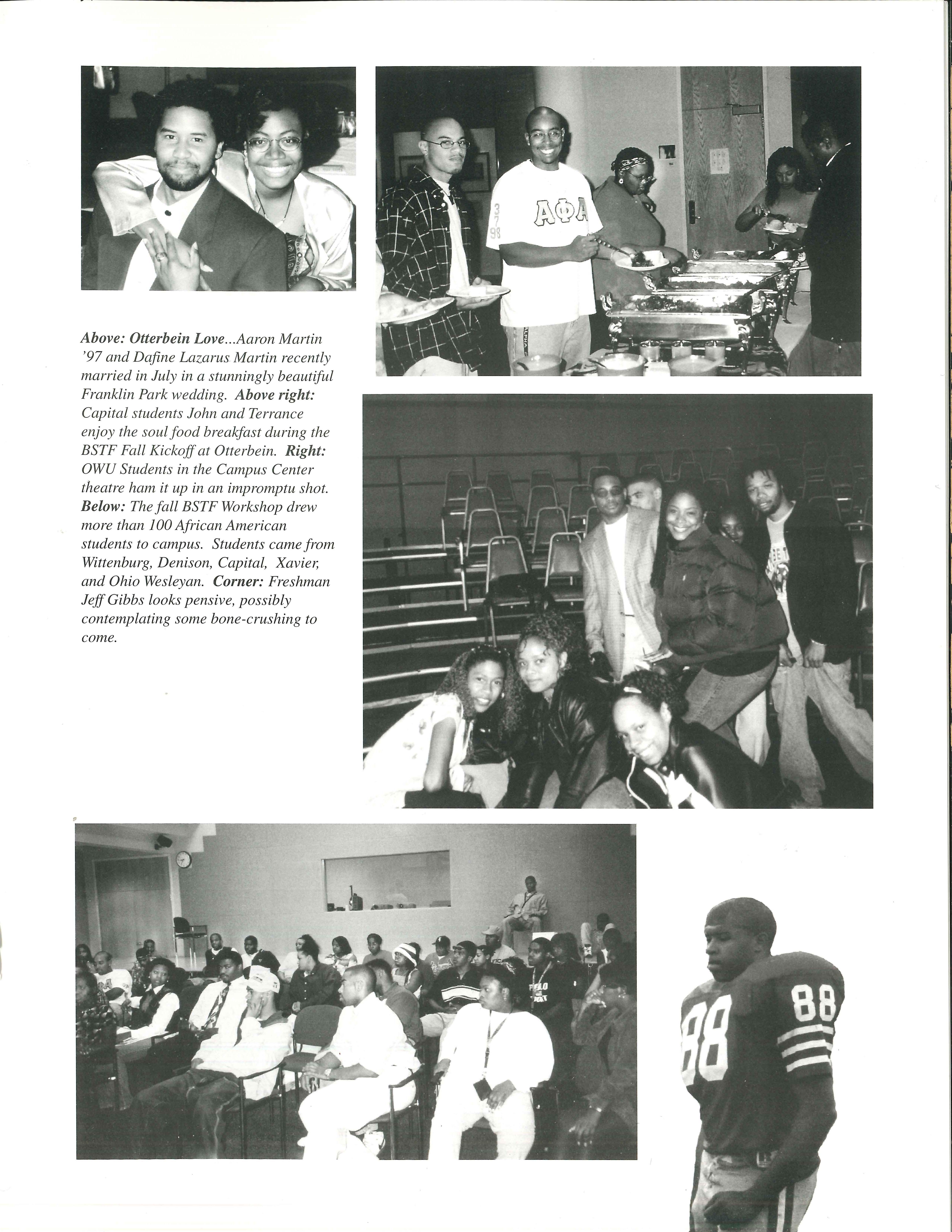
Above: Otterbein Love .. .Aaron Martin '97 and Dafine Lazarus Martin recently married in July in a stunningly beautiful Franklin Park wedding. Above right: Capital students John and Terrance enjoy the soul food breakfast during the BSTF Fall Kickoff at Otterbein. Right: OWU Students in the Campus Center theatre ham it up in an impromptu shot. Below: The fall BSTF Workshop drew more than JOO African American students to campus. Students came from Wittenburg, Denison, Capita l, Xavier, and Ohio Wesleyan. Corner: Fres hman Jeff Gibbs looks pensive, possibly contemplating some bone-crushing to come
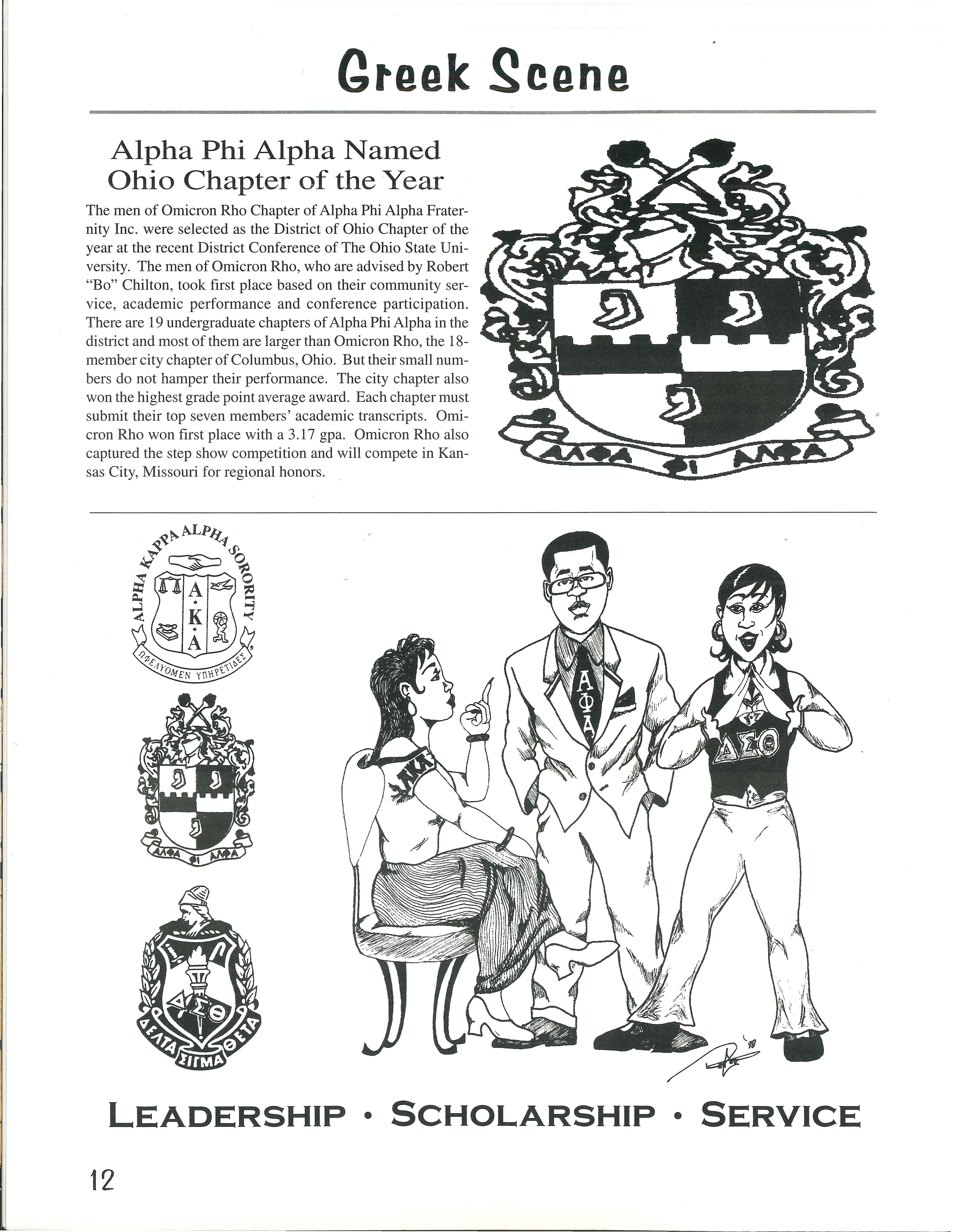
The men of Omicron Rho Chapter of Alpha Phi Alpha Fraternity Inc. were selected as the District of Ohio Chapter of the year at the recent District Conference of The Ohio State University The men of Omicron Rho, who are advised by Robert "Bo" Chilton, took first place based on their community service, academic performance and conference participation. There are 19 undergraduate chapters of Alpha Phi Alpha in the district and most of them are larger than Omicron Rho, the 18member city chapter of Columbus, Ohio. But their small numbers do not hamper their performance . The city chapter also won the highest grade point average award. Each chapter must submit their top seven members ' academic transcripts. Omicron Rho won first place with a 3.17 gpa Omicron Rho also captured the step show competition and will compete in Kansas City, Missouri for regional honors.
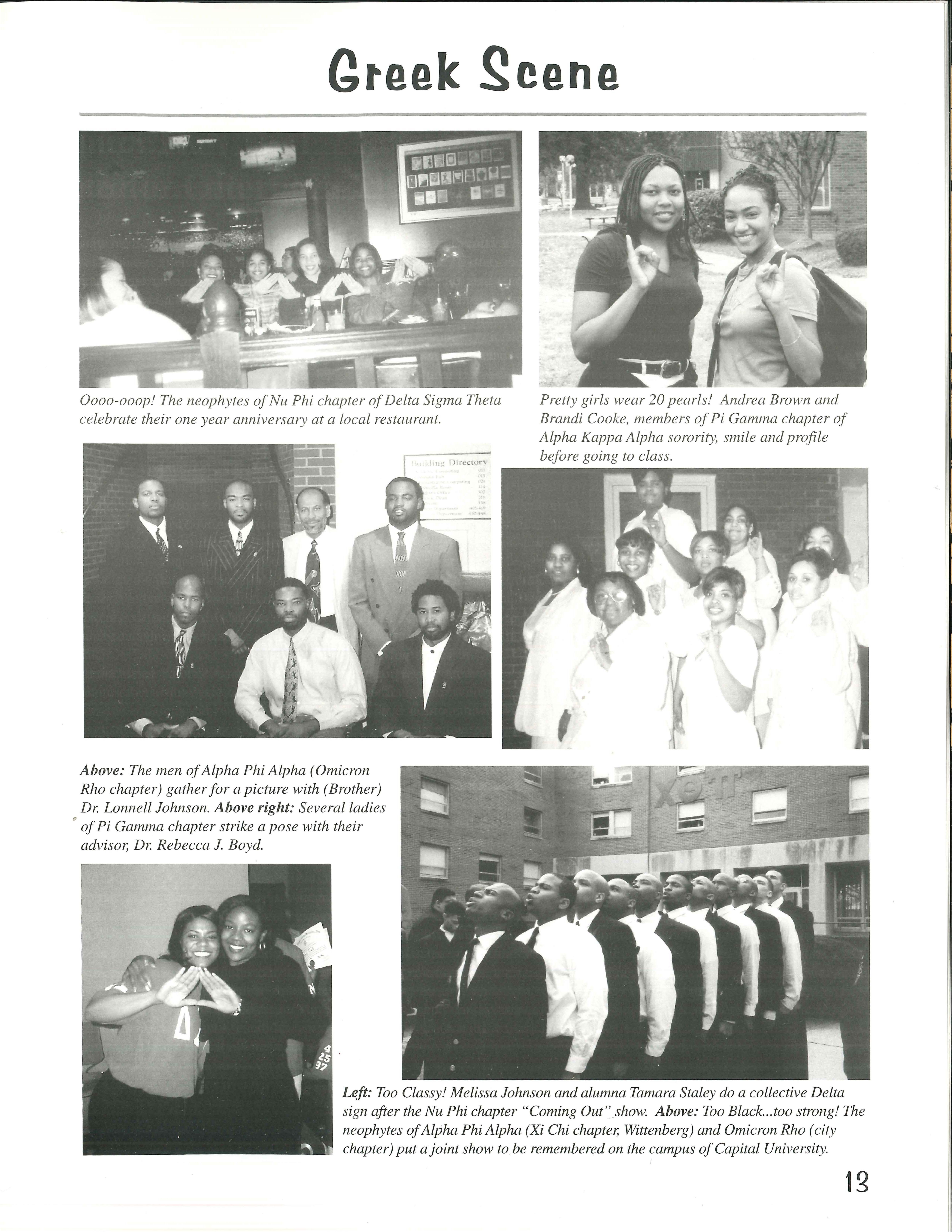
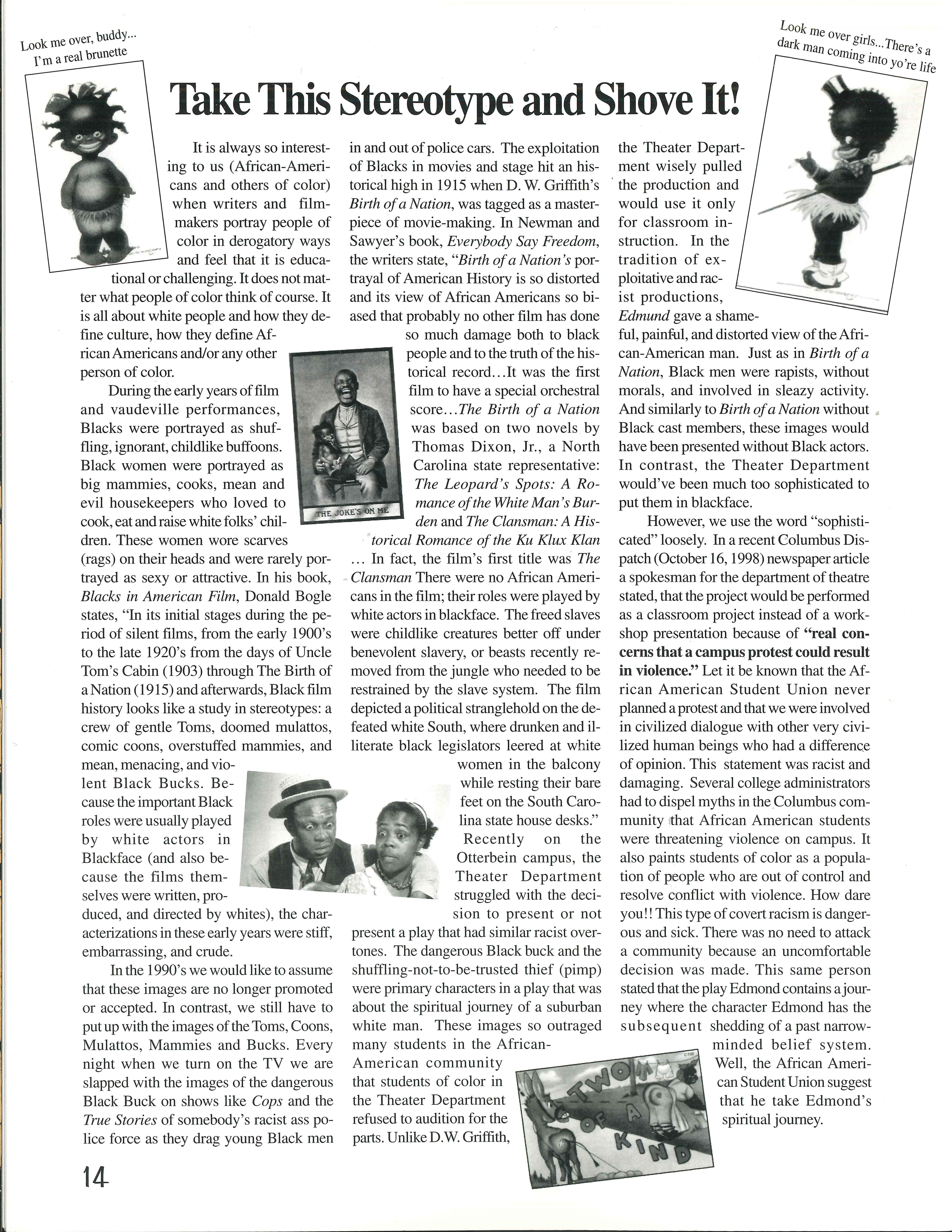
It is always so interesting to us (African-Americans and others of color) when writers and filmmakers portray people of color in derogatory ways and feel that it is educational or challenging It does not matter what people of color think of course It is all about white people and how they define culture, how they define African Americans and/or any other person of color.
During the early years of film and vaudeville performances, Blacks were portrayed as shuffling, ignorant, childlike buffoons. Black women were portrayed as big mammies , cooks, mean and evil housekeepers who loved to cook, eat and raise white folks' children. These women wore scarves (rags) on their heads and were rarely portrayed as sexy or attractive In his book , Blacks in American Film, Donald Bogle states , "In its initial stages during the period of silent films , from the early 1900 ' s to the late 1920 ' s from the days of Uncle Tom ' s Cabin (1903) through The Birth of a Nation (1915) and afterwards, Black film history looks like a study in stereotypes: a crew of gentle Toms , doomed mulattos , comic coons , overstuffed mammies , and mean , menacing , and violent Black Bucks. Because the important Black roles were usually played by whit e actors i n Blackface (and also bec a use the films themselves were written , produced , and directed by whites) , the characterizations in these early years were stiff, embarrassing , and crude . In the 1990's we would like to assume that these images are no longer promoted or accepted. In contrast, we still have to put up with the images of the Toms , Coons , Mulattos , Mammies and Bucks. Every night when we turn on the TV we are slapped with the images of the dangerous Black Buck on shows like Cops and the True Stories of somebody ' s racist ass police force as they drag young Black men
in and out of police cars. The exploitation of Blacks in movies and stage hit an historical high in 1915 when D W. Griffith ' s Birth of a Nation, was tagged as a masterpiece of movie-making In Newman and Sawyer' s book, Everybody Say Freedom, the writers state, "Birth of a Nation 's portrayal of American History is so distorted and its view of African Americans so biased that probably no other film has done so much damage both to black people and to the truth of the historical record .It was the first film to have a special orchestral score ... The Birth of a Nation was based on two novels by Thomas Dixon, Jr., a North Carolina state representative : The Leopard's Spots: A Romance of the White Man 's Burden and The Clansman : A Historical Romance of the Ku Klux Klan In fact , the film's first title was The Clansman There were no African Americans in the film ; their roles were played by white actors in blackface The freed slaves were childlike creatures better off under benevolent slavery, or beasts recently removed from the jungle who needed to be restrained by the slave system. The film depicted a political stranglehold on the defeated white South, where drunken and illiterate black legislators leered at w h ite women in the balcony while resting their bare feet on the South Carolina state house desks."
Recently on the Otterbein campus , the Theater Department struggled with the decision to present or not present a play that had similar racist overtones. The dangerous Black buck and the s huffling-not-to-be-trusted thief (pimp) were primary characters in a play that was a bout the spiritual journey of a suburban white man. These images so outraged many students in the AfricanAmerican community that students of color in the Theater Department refused to audition for the parts. Unlike D .W. Griffith ,
the Theater Department wisely pulled the production and would use it only for classroom instruction. In the tradition of exploitative and racist productions, Edmund gave a shameful, painful, and distorted view of the African-American man Just as in Birth of a Nation , Black men were rapists , without morals, and involved in sleazy activity. And similarly to Birth of a Nation without Black cast members, these images would have been presented without Black actors. In contrast , the Theater Department would've been much too sophisticated to put them in blackface.
However, we use the word " sophisticated" loosely. In a recent Columbus Dispatch (October 16, 1998) newspaper article a spokesman for the department of theatre stated, that the project would be performed as a classroom project instead of a workshop presentation because of "real concerns that a campus protest could result in violence." Let it be known that the African American Student Union never planned a protest and that we were involved in civilized dialogue with other very civilized human beings who had a difference of opinion This statement was racist and damaging Several college administrators had to dispel myths in the Columbus community that African American students were threatening violence on campus. It also paints students of color as a population of people who are out of control and resolve conflict with violence. How dare you!! This type of covert racism is dangerous and sick. There was no need to attack a community because an uncomfortable decision was made . This same person stated that the play Edmond contains a journey where the character Edmond has the subsequent shedding of a past narrowminded belief system.
Well, the African American Student Union suggest that he take Edmond ' s spiritual journey
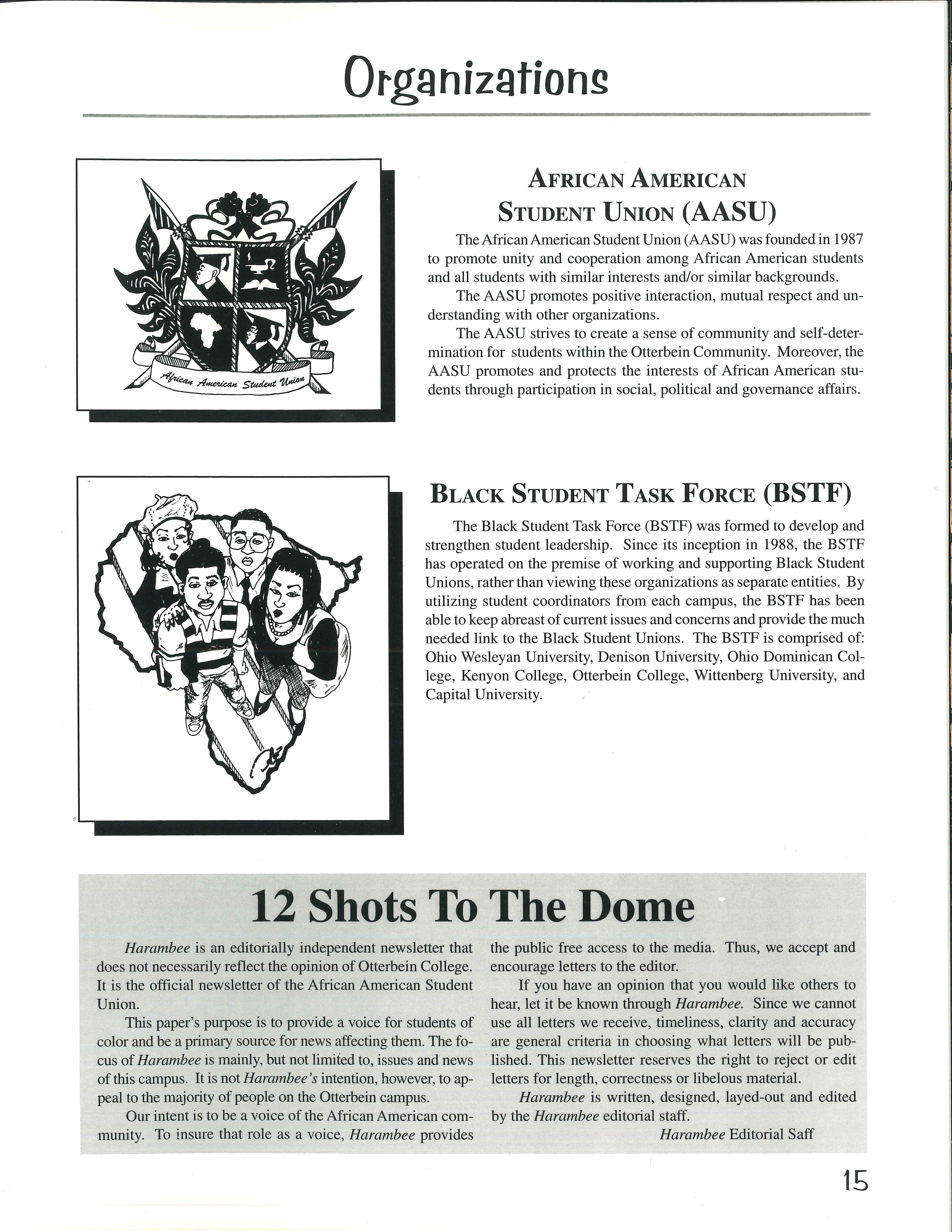
The African American Student Union (AASU) was founded in 1987 to promote unity and cooperation among African American students and all students with similar interests and/or similar backgrounds.
The AASU promotes positive interaction, mutual respect and understanding with other organizations
The AASU strives to create a sense of community and self-determination for students within the Otterbein Community. Moreover, the AASU promotes and protects the interests of African American students through participation in social, political and governance affairs
The Black Student Task Force (BSTF) was formed to develop and strengthen student leadership. Since its inception in 1988 , the BSTF has operated on the premise of working and supporting Black Student Unions, rather than viewing these organizations as separate entities. By utilizing student coordinators from each campus , the BSTF has been able to keep abreast of current issues and concerns and provide the much needed link to the Black Student Unions. The BSTF is comprised of: Ohio Wesleyan University , Denison University, Ohio Dominican College , Kenyon College, Otterbein College, Wittenberg University, and Capital University.
Harambee is an editorially independent newsletter that does not necessarily reflect the opinion of Otterbein College It is the official newsletter of the African American Student Union . This paper's purpose is to provide a voice for students of color and be a primary source for news affecting them. The focus of Harambee is mainly, but not limited to , issues and news of this campus. It is not Harambee 's intention, however, to appeal to the majority of people on the Otterbein campus.
Our intent is to be a voice of the Afric an American community To insure that ro le as a voice, Harambee provides the public free access to the media . Thus, we accept and encourage letters to the editor. If you have an opinion that you would like others to hear, let it be known through Harambee. Since we cannot use all letters we receive, timeliness , clarity and accuracy are general criteria in choosing what letters will be published. This newsletter reserves the right to reject or edit letters for length, correctness or libelous material. Harambee is written , designed, layed-out and edited by the Harambee editorial staff. Harambee Editorial Saff
Dear Sisters:
Greetings!! My name is Kellea Tibbs and I am the America Reads Coordinator for the Community Service Learning Center. Being new here at Otterbein College, I have gotten to know the campus and the undergraduate student body very well. As an AfricanAmerican female graduate of a predominantly White college, I know what its like to be intimidated , scared , and somewhat confused about my role on campus as well as about my career goals and my goals in life
The whole college experience opens your eyes and your mind to a new world of ideals , cultures , and philosophies that man y of us may have never thought about prior to corning to college. S ome of us are ro oted and grounded in the spirituality th at stems from being raised in the Black church , while others of us are exposed to factors in our live s such as abuse , teen pregnancy, alcohol , drugs , divo rce , e tc ., that are beyond our control and o ften lead to low self e s teem and low sel f image. We are bombarded with society ' s view of what i t is to be the " ide al" woman , which o ften turns out to be in the form of someone W hit e. Some of us are taught to love our selves , to love our hair, our full figure s, etc. , while some of us are taught to hate o ursel ves , hate our skin , a nd to hate our heritage Some of us are also very co mfortable with our sexuality, while other s of us ar e uncomfortable with sex , our bodies , and how to love , not only others , but o ur sel ve s.
A ll of the se i ss ues can be add ress ed if we just learn to talk to one another and to b e o pen w ith o ne another. C o lleg e s ho uld be lo o ked at as no t on ly a pl ace to le arn i n sid e of a classroo m setting but o uts i de t he cl a s sroo m as we ll. We , a s Bl ack Wo men m us t learn to c o m m unica te with o ne ano th er and sha re o u r fe e ling s about academic s, relation s hip s , sel f image, and our chosen career paths.
As a new staff member at Otterbein, I hope to get to know the students, and hope to become a resource for any questions you may have not only about community service, but also about surviving in college as an African American woman
I say all this to invite you to join Sisters United, a support group that will begin in Winter Quarter. However, before winter quarter arrives, I hope to gather information from you that will allow me and other facilitators to gauge your interests and needs as African -American women here at Otterbein College . This support group will be exclusively designed to help you meet both your academic and longtime personal goals. There a re three areas that will be focused on within the group: Academics, Support, and Career Interests. (Not to mention some social/ cultural experiences.)
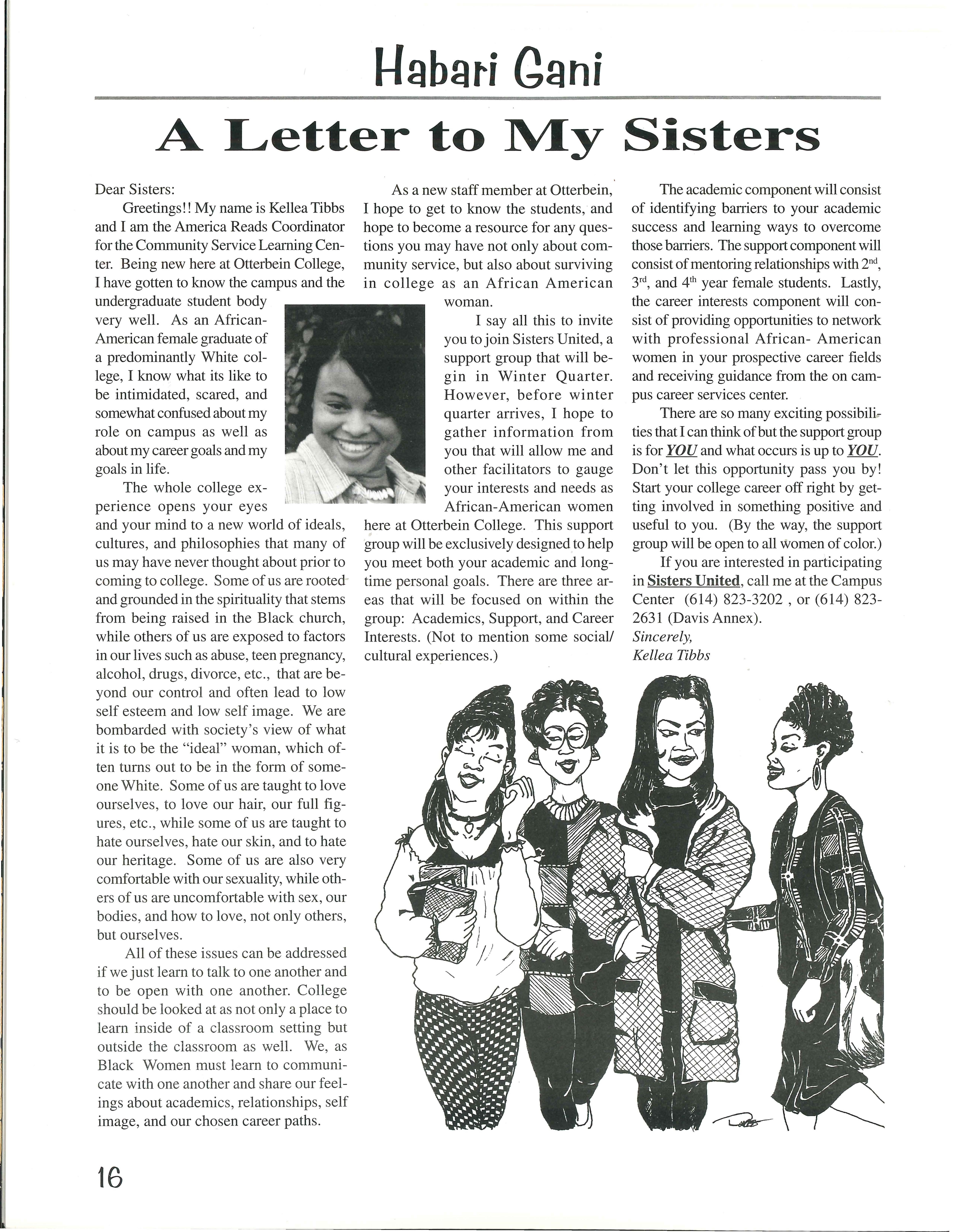
The academic component will consist of identifying barriers to your academic success and learning ways to overcome those barriers. Tne support component will consist of mentoring relationships with 2nd , 3rd,and 4th year female students. Lastly, the career interests component will consist of providing opportunities to network with professional African - American women in your prospective career fields and receiving guidance from the on campus career services center.
There are so many exciting possibilities that I can think of but the support group is for YOU and what occurs is up to YOU. Don't let this opportunity pass you by! Start your college career off right by getting involved in something positive and useful to you. (By the way, the support group will be open to all women of color.) If you are interested in participating i n Sisters United, call me at the Campus Center (614) 823-3202, or (614) 8232631 (Davis Annex).
Sincerely, Kellea Tibbs
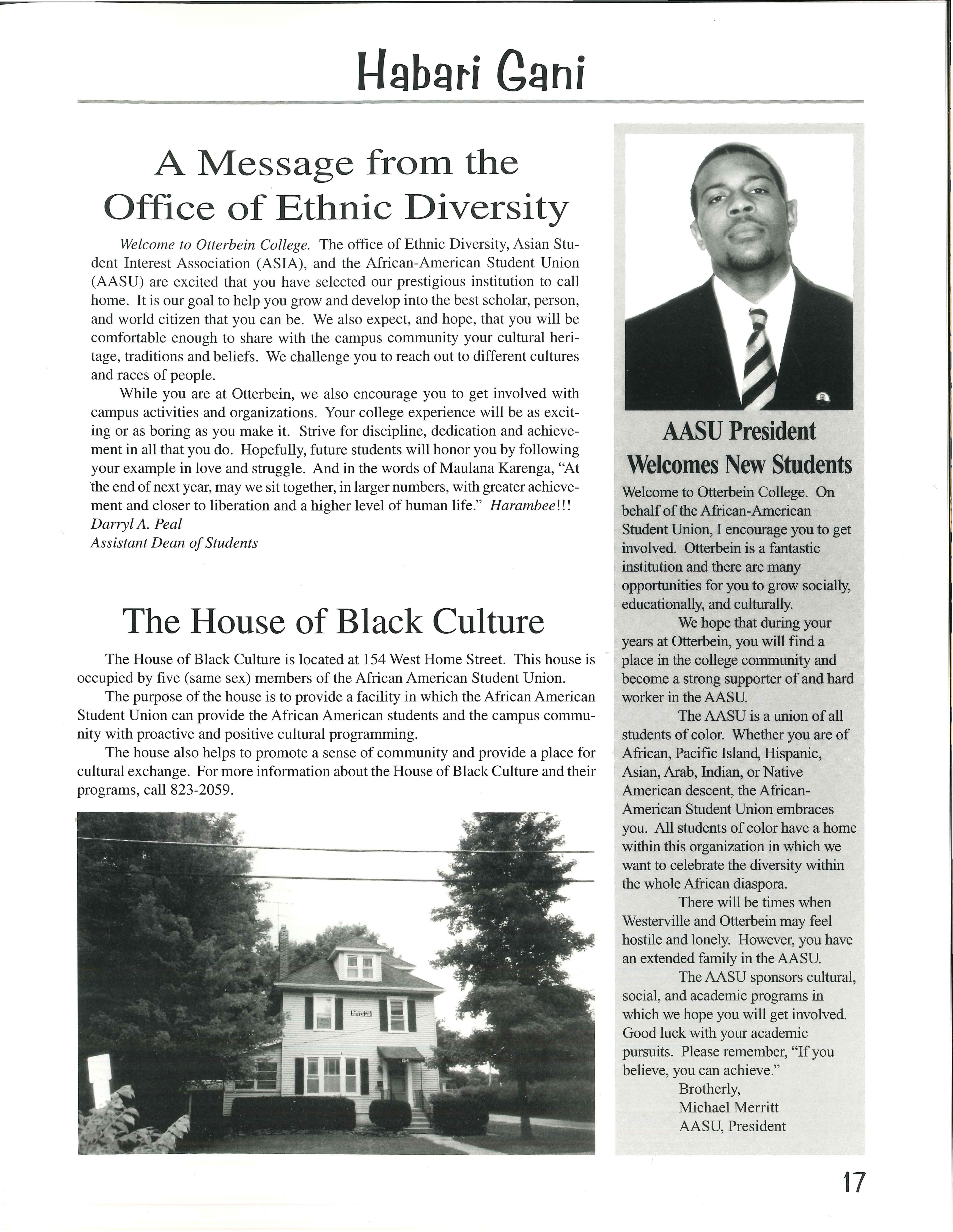
Welcome to Otterb e in College The office of Ethnic Diversity, Asian Student Interest Association (ASIA), and the African-American Student Union (AASU) are excited that you have selected our prestigious institution to call home. It is our goal to help you grow and develop into the best scholar, person , and world citizen that you can be. We also expect , and hope , that you will be comfortable enough to share with the campus community your cultural heritage , traditions and beliefs . We challenge you to reach out to different cultures and races of people.
While you are at Otterbein, we also encourage you to get involved with campus activities and organizations. Your college experience will be as exciting or as boring as you make it. Strive for discipline, dedication and achievement in all that you do. Hopefully, future students will honor you by following your example in love and struggle And in the words of Maulana Karenga , "At the end of next year, may we sit together, in larger numbers, with greater achievement and closer to liberation and a higher level of human life ." H arambee !!!!
Darryl A. Peal
Assistant Dean of Students
The House of Black Culture is located at 154 West Home Street. This house is occupied by five (same sex) members of the African American Student Union.
The purpose of the house is to provide a facility in which the African American Student Union can provide the African American students and the campus community with proactive and positive cultural programming.
The house also helps to promote a sense of community and provide a place for cultural exchange. For more information about the House of Black Culture and their programs, call 823-2059 .
Welcome to Otterbein College On behalf of the African-American Student Union, I encourage you to get involved. Otterbein is a fantastic institution and there are many opportunities for you to grow socially, educationally, and culturally.
We hope that during your years at Otterbein, you will find a place in the college community and become a strong supporter of and hard worker in the AASU.
The AASU is a union of all students of color. Whether you are of African, Pacific Island, Hispanic, Asian, Arab, Indian, or Native American descent, the AfricanAmerican Student Union embraces you. All students of color have a home within this organization in which we want to celebrate the diversity within the whole African diaspora.
There will be times when Westerville and Otterbein may feel hostile and lonely However, you have an extended family in the AASU.
The AASU sponsors cultural, social, and academic programs in which we hope you will get involved Good luck with your academic pursuits . Please remember, "If you believe, you can achieve."
Brotherly, Michael Merritt
AASU, President
Andrea Brown, Senior -
What does Black History Month mean to you? It is a time to remember great African American men and women of the past who have made valid contributions to the African American community and the nation as a whole.
What is something positive and negative coming out of urban music today? Positive - educational message about fatherhood and the importance of having common sense. Negative - sex ist, degrading lyrics about women and their sexuality; an overall lack ofrespect for the B lack woman!
If you could bring back one ol'skool TV sitcom what would it be: 227, Different World, The Jeffersons, The Cosby Show, Sanford & Son, or other? What's Happenin?!!
Chasity Lambert, Freshman
What does Black History Month mean to you? The month to celebrate our history and heritage. A month that should be celebrated all year 'round.
What is something positive and negative coming out of urban music today? Some positive messages are coming out but I think that there are more negative than positive. In my opinion many fema le rappers do not know how to rap so they sell sex.
If you could bring back one ol'skool TV sitcom what would it be: 227, Different World, The Jeffersons, The Cosby Show, Sanford & Son, or other? The Cosby Show.
The African - American Student Union and Otterbein College are pleased to welcome Chris Barnett and Al Wilson to the African -American Student
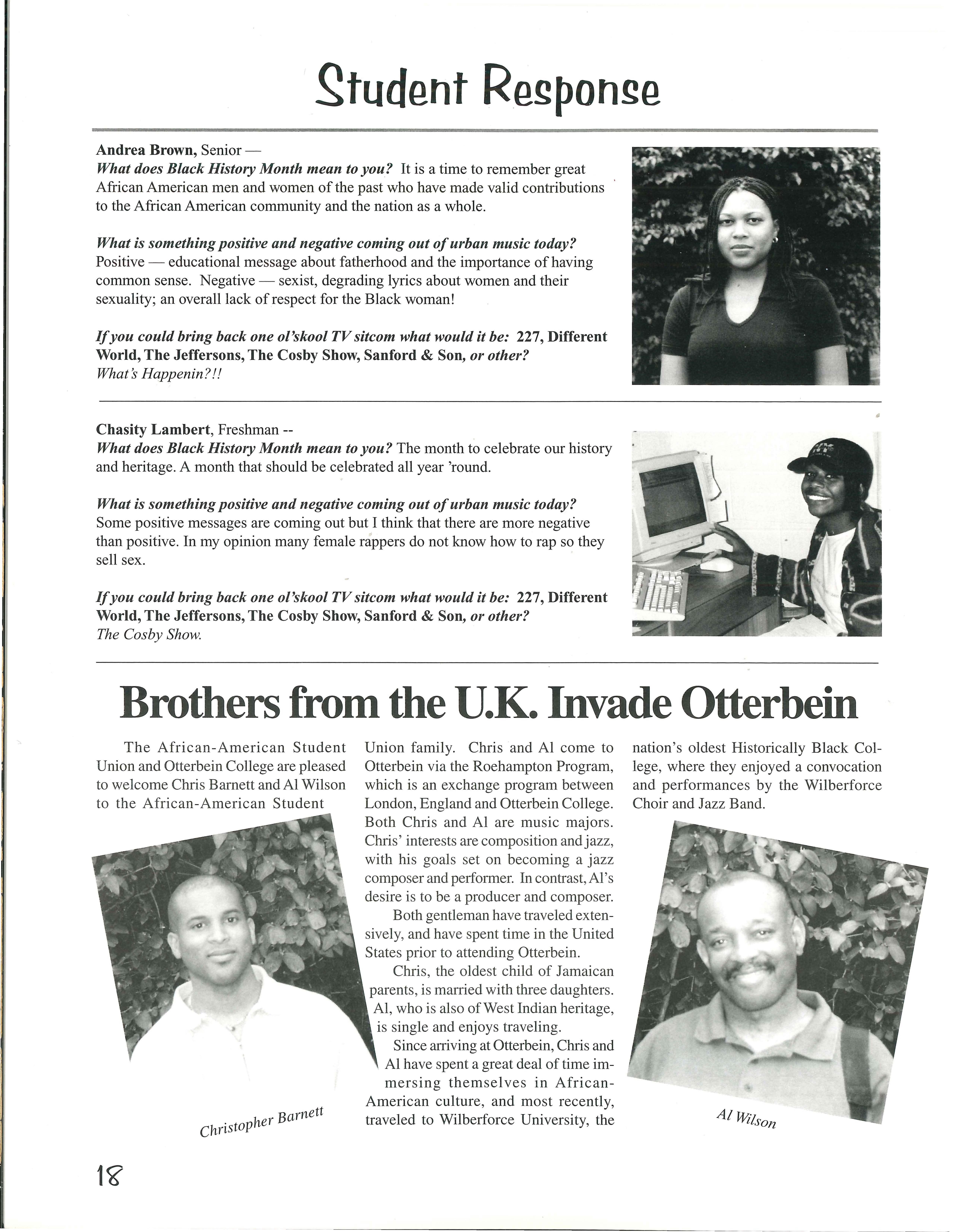
Barnett Christopher
Union family . Chris and Al come to Otterbein via the Roehampton Program, which is an exchange program between London, England and Otterbein College. Both Chris and Al are music majors Chris' interests are composition and jazz , with his goals set on becoming a jazz composer and performer. In contrast , Al's desire is to be a producer and composer. Both gentleman have traveled extensively, and have spent time in the United States prior to attending Otterbein.
Chris , the oldest child of Jamaican parents , is married with three daughters. Al, who is also of West Indian heritage , is single and enj oys traveling . Si nce arriving at Otterbein, Chris and Al have spent a great deal of time immersing themselves in AfricanAmerican c ulture , and most recen tly , traveled to Wil berforc e University, the
nation's oldest Historically Black College, where they enjoyed a convocation and performances by the Wilberforce Choir and Jazz Band.
Al Wilson
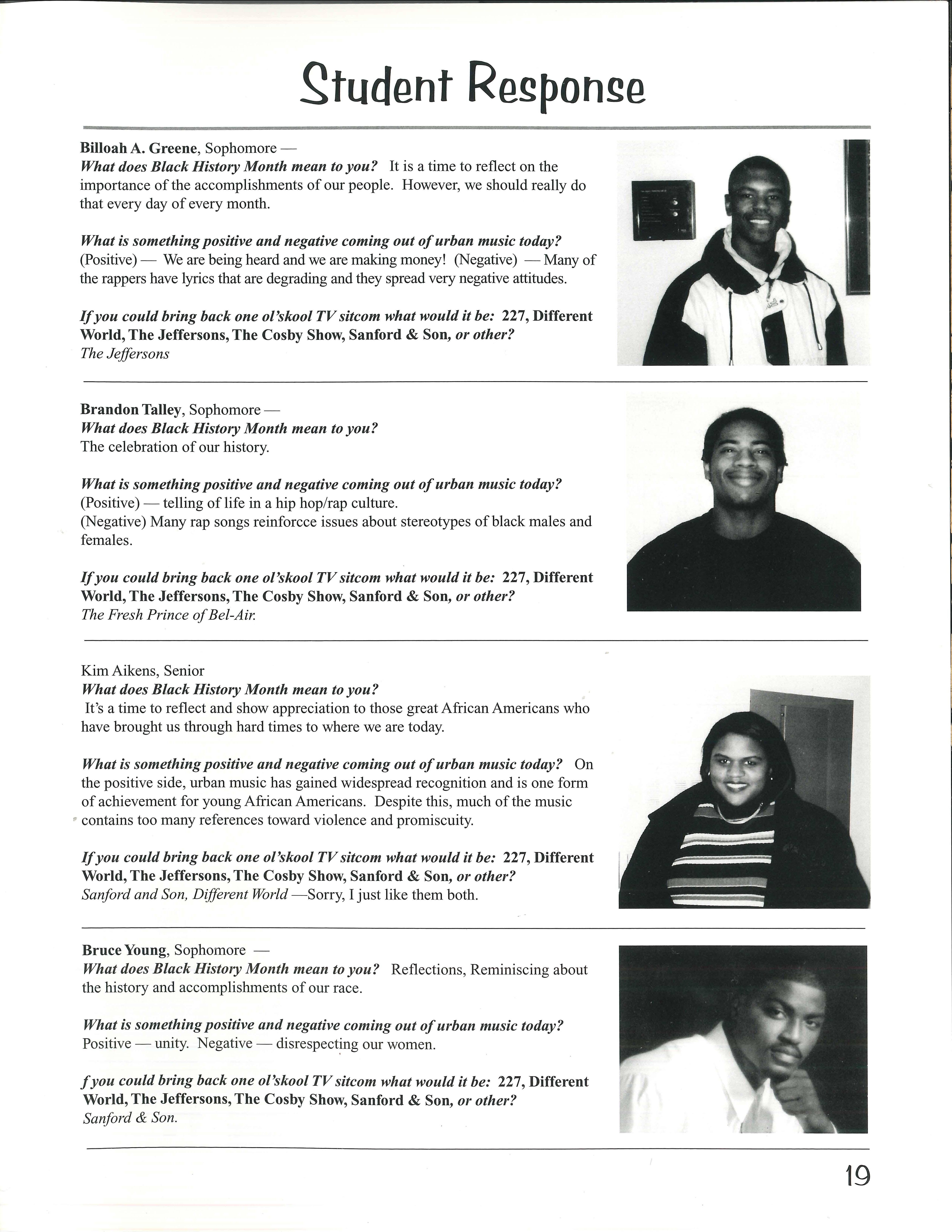
Billoah A. Greene , Sophomore -
What does Black History Month mean to you? It is a time to reflect on the importance of the accomplishments of our people. However, we should really do that every day of every month .
What is something positive and negative coming out of urban music today? (Positive) - We are being heard and we are making money! (Negative) - Many of the rappers have lyrics that are degrading and they spread very negative attitudes.
If you could bring back one ol'skool TV sitcom what would it be: 227, Different World, The Jeffersons, The Cosby Show, Sanford & Son, or other? The Jeffersons
Brandon Talley , SophomoreWhat does Black History Month mean to you?
The celebration of our history
What is something positive and negative coming out of urban music today? (Positive) - telling of life in a hip hop /rap culture. (Negative) Many rap songs reinforcce issues about stereotypes of black males and females.
If you could bring back one ol'skool TV sitcom what would it be: 227, Different World, The Jeffersons, The Cosby Show, Sanford & Son, or other? The Fresh Prince of Bel-Air.
Kim Aikens, Senior
What does Black History Month mean to you?
It 's a time to reflect and show appreciation to those great African Americans who have brought us through hard times to where we are today.
What is something positive and negative coming out of urban music today? On the positive side , urban music has gained widespread recognition and is one form of achievement for young African Americans Despite this, much of the music contains too many references toward violence and promiscuity.
If you could bring back one ol'skool TV s itcom what would it be: 227, Different World, The Jeffersons, The Cosby Show, Sanford & Son, or other? Sanford and Son , Different World - Sorry, I just like them both.
Bruce Young , SophomoreWhat does Black History Month mean to you? Reflections, Reminiscing about the history and accomplishments of our race
What is something positive and negative coming out of urban music today? Positive - unity. Negative - disrespecting our women .
f you could bring back one ol'skool TV sitcom what would it be: 227, Different World, The Jeffersons, The Cosby Show, Sanford & Son, or other? Sanford & Son.
Building Dire
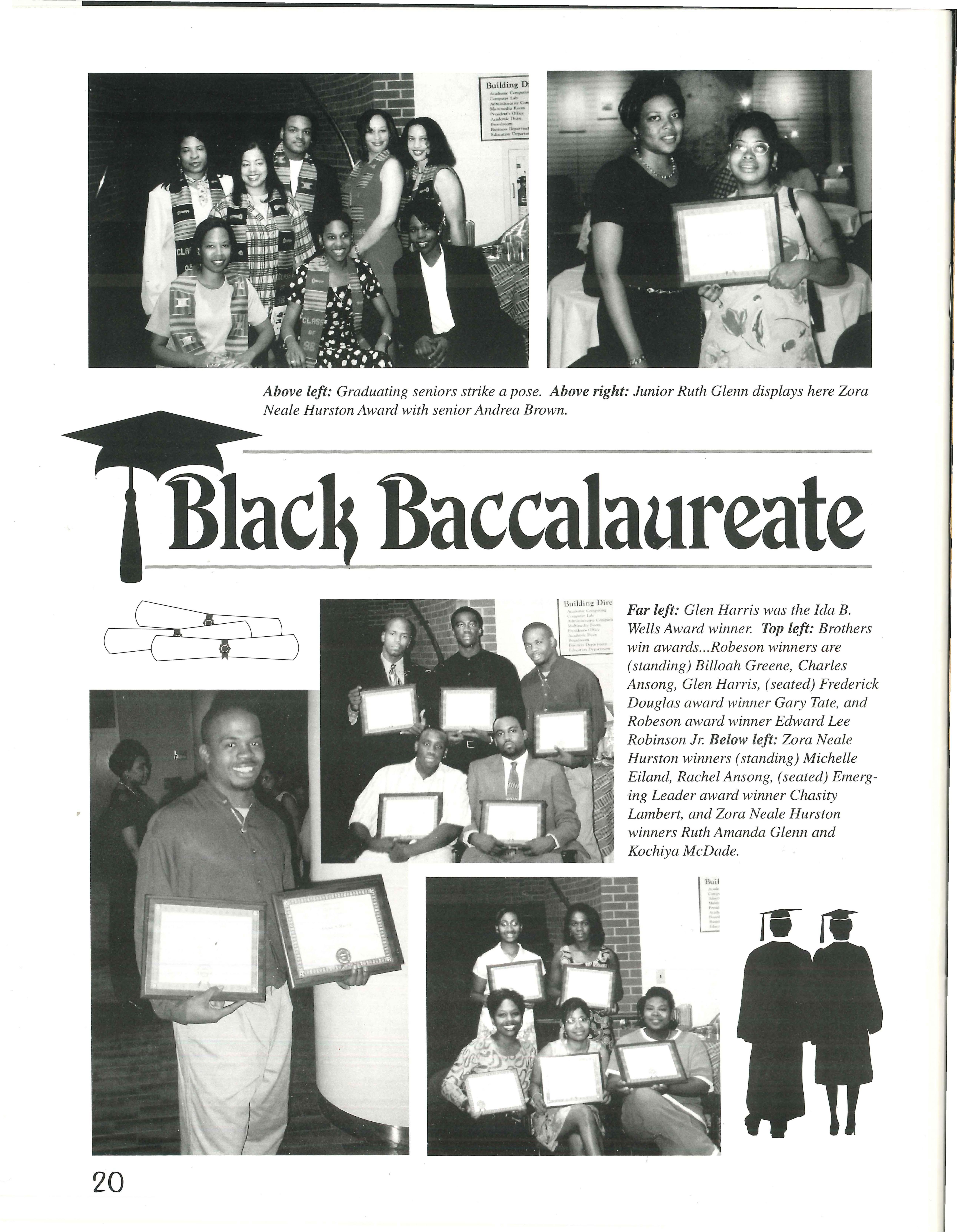
Far left: Glen Harris was the Ida B. Wells Award winner. Top left: Brothers win awards Robeson winners are (standing) Billoah Greene, Charles Ansong, Glen Harris, (seated) Frederick Douglas award winner Gary Tate, and Robeson award winner Edward Lee Robinson Jr. Below left: Zora Neale Hurston winners (standing) Michelle Eiland, Rachel Ansong, (seated) Emerging Leader award winner Chasity Lambert, and Zora Neale Hurston winners Ruth Amanda Glenn and Kochiya McDade